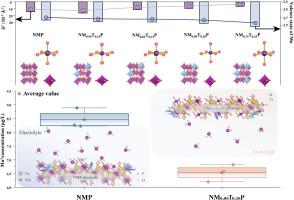通过电子-晶格耦合调制jhn - teller畸变以提高先进钠离子电池的聚阴离子阴极的循环稳定性
IF 20.2
1区 材料科学
Q1 CHEMISTRY, PHYSICAL
引用次数: 0
摘要
锰基聚阴离子化合物具有成本效益、高电压性能和环境友好性,是钠离子电池最有前途的正极材料之一。然而,高自旋Mn3+态的强jhn - teller畸变(JTD)会引起局部应力集中和不可逆结构崩溃,而低JTD态通过增强Mn-O键共价导致晶格刚度升高,导致电化学稳定性下降。在此,我们提出了一种电子-晶格耦合调制策略,通过在聚阴离子NaMnPO4框架内构建Ti4+介导的Mn-O-Ti超交换相互作用,实现电子态重构和动态晶格响应,以实现可控JTD调节。我们发现Ti4+ d0和o2p之间的强轨道杂化增强了Mn -O键的共价,使Mn3+ eg轨道拓宽为Mn(eg)-O(2p)杂化带,从而降低了Mn3+ eg轨道的本征电子简并度。此外,柔性TiO6八面体通过弹性变形促进均匀可逆微应变,并使晶格应力有效消散。与原始样品相比,NaMn0.80Ti0.20PO4的最佳JTD量级为σ2 = 0.009,应变均匀性提高了91.03%。这些增强有助于在2℃下循环500次后保持96.75%的高容量(相比之下,NaMnPO4为77.85%)。本研究为高自旋过渡金属阴极的JTD调制建立了一个通用范例,为高稳定性阴极设计开辟了新的途径。本文章由计算机程序翻译,如有差异,请以英文原文为准。

Tailored Modulation of Jahn-Teller Distortion via Electron-Lattice Coupling to Enhance the Cycling Stability of Polyanionic Cathodes for Advance Sodium-Ion Batteries
Manganese-based polyanionic compounds are one of the most promising cathode materials for sodium-ion batteries due to cost-effectiveness, high-voltage capability, and environmental friendliness. Nevertheless, the strong Jahn-Teller distortion (JTD) in high-spin Mn3+ state induces localized stress concentration and irreversible structural collapse, while the low-JTD state causes elevated lattice rigidity via enhanced Mn–O bond covalency, leading to inferior electrochemical stability. Herein, we propose an electron-lattice coupling modulation strategy by constructing a Ti4+-mediated Mn-O-Ti superexchange interactions within the polyanionic NaMnPO4 framework to enable electronic state reconfiguration and dynamic lattice response for controllable JTD regulation. We show that the strong orbital hybridization between Ti4+ d0 and O 2p enhances the covalency of Mn–O bonds and broadens the Mn3+ eg orbitals into Mn(eg)-O(2p) hybridized bands, thus reducing the intrinsic electron degeneracy of the Mn3+ eg orbitals. Furthermore, the flexible TiO6 octahedra facilitate homogeneous reversible microstrains through elastic deformation and enable effective lattice stress dissipation. The NaMn0.80Ti0.20PO4 exhibits an optimal JTD magnitude of σ2 = 0.009 and a 91.03% improvement in strain homogeneity compared to the pristine sample. These enhancements contribute to a high-capacity retention of 96.75% after 500 cycles at 2 C. (vs. 77.85% for NaMnPO4). This work establishes a universal paradigm to modulate the JTD in high-spin transition-metal cathodes, opening new avenues for high-stability cathode design.
求助全文
通过发布文献求助,成功后即可免费获取论文全文。
去求助
来源期刊

Energy Storage Materials
Materials Science-General Materials Science
CiteScore
33.00
自引率
5.90%
发文量
652
审稿时长
27 days
期刊介绍:
Energy Storage Materials is a global interdisciplinary journal dedicated to sharing scientific and technological advancements in materials and devices for advanced energy storage and related energy conversion, such as in metal-O2 batteries. The journal features comprehensive research articles, including full papers and short communications, as well as authoritative feature articles and reviews by leading experts in the field.
Energy Storage Materials covers a wide range of topics, including the synthesis, fabrication, structure, properties, performance, and technological applications of energy storage materials. Additionally, the journal explores strategies, policies, and developments in the field of energy storage materials and devices for sustainable energy.
Published papers are selected based on their scientific and technological significance, their ability to provide valuable new knowledge, and their relevance to the international research community.
 求助内容:
求助内容: 应助结果提醒方式:
应助结果提醒方式:


